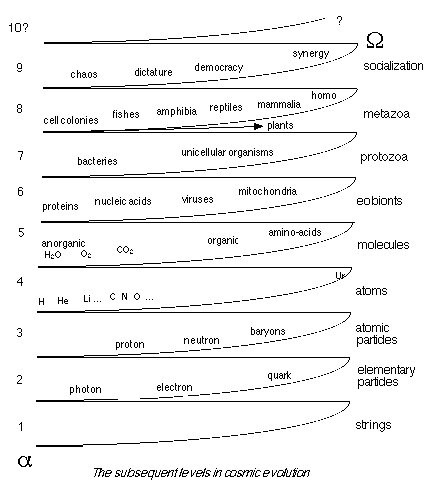Homepage
Texts Menu
Main Menu
The Integrative Style
|
The Facts of Evolution
THE FUNDAMENTAL MECHANISM
The continuous development of the universe was already depicted by Teilhard's predecessors. He stated that this development towards more complex systems and organisms progresses along two movements: (1) a complexification within the own level, i.e. more complex "variations" with the same building blocks; and (2) a complexification by jumping to a higher level, i.e. using elements of the former level as building blocks. The second movement starts when the first reaches its end, as if nature considered more trials within the actual level as non-productive. This fundamental process generated, up to now, nine levels of complexification, as far as scientific knowledge reaches. It's nice to remember that Teilhard "forgot" stages 1, 2 and 6, and proposed a 6-layer model. But it's impressive to consider that those three "new" levels smoothly shoved into the existing model, rather confirming than refuting it.

The subsequent levels in the evolution of the Universe
Those 9 layers are:
(1) the (super)strings.
(2) the elementary particles: quarks, the photon and the electron; they are complexes of strings.
(3) the atomic particles, including protons, neutrons and baryons; they are complexes of quarks.
(4) the atoms, ranging from Hydrogen to Uranium (everything beyond Uranium is artificial, and very shortliving); they are complexes of elementary particles.
(5) the molecules, including the anorganic (e.g. water), evolving to the organic (with the amino-acids); they are complexes of atoms
(6) the eobionts or protoplasmic organisms, ranging from poorly organized proteins to complex organelles, i.e. cell constituents that existed autonomously, outside the cell, at a certain point in evolution, and also viruses, but today are only found inside cells; they are complexes of proteins and other organic and anorganic molecules.
(7) the protozoa, i.e. the individual cell evolving from primitive organisms to organized complexes of organelles
(8) the metazoa, i.e. the animals (and a side branch of plants), ultimately evolving to mammalian, hominoids and man; they are complexes of cells.
(9) the socialization, i.e. a symbiosis of humans, a mental noosphere, organizing not only society, but also matter on a planetary and universal scale, and probably interacting and cooperating one day with intelligent beings from other inhabited planets.
SOME ARGUMENTS FOR THIS HYPOTHESIS
Arguments that sustain the complexity-consciousness hypothesis include:
(1) The extreme simplicity of the system, never surpassed to date by a more general or more simple explanation. It's a kind of natural systems theory.
(2) The apparent extinction of evolution at a certain level once a higher level is started. It is even extremely difficult if not impossible to transgress these natural limits.
(3) The fact that at each level, organisms are using building blocks form the former level, and nearly never from more primitive levels. E.g. in a metazoon, everything, including the rigid bones and the shield of the turtle, and even blood, is composed of living cells. Only man (starting with the primates) invents technology, i.e. using tools composed of elements of lower levels
(4) It is striking that the duration of each level shortens with the same factor, i.e. 0.618 (the Golden Section), with the exception of the first two or three levels, disappearing in the mist of relativistic speeds. This temporal regularity suggests a fundamental process.
Est. 11/01 - Latest Update 17/2/02
|